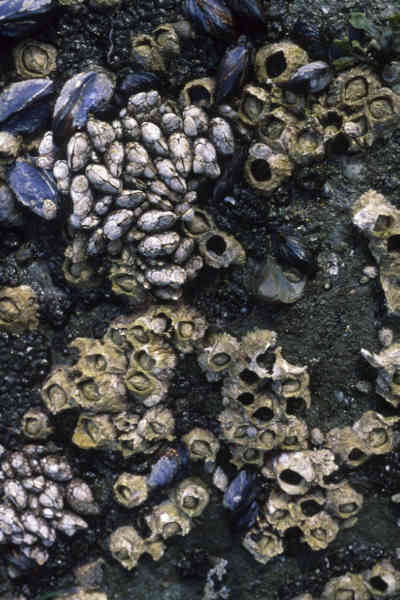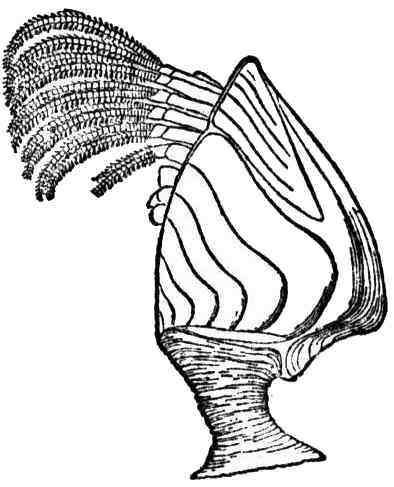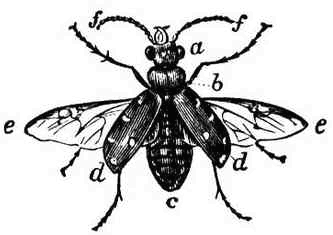 There
are many arthropods in the world, but many do not have a hard part that can be
preserved. Many of your students would be familiar with a crab. Have them
compare a crab shell with that of the coral and make sure they notice the
difference in hardness. The lack of very hard parts prevent many arthropods
from becoming fossils. There
are many arthropods in the world, but many do not have a hard part that can be
preserved. Many of your students would be familiar with a crab. Have them
compare a crab shell with that of the coral and make sure they notice the
difference in hardness. The lack of very hard parts prevent many arthropods
from becoming fossils.
Arthropods have a problem when they grow. Their shell does not grow with
them. They must get rid of the old skeleton and replace it with a new one
(called molting). Many times your students will see on the beach small
"dead" crab shells, this is many successive molts of the crabs.
 A
barnacle which is a shrimp-like creature lives on its back inside the
skeleton. It has a little lid that covers the organisms when it is not
submerged with water. When water covers the barnacles the lid opens and the
barnacles' appendages come out and feed on any food that might pass by or
settle down on its appendages. A
barnacle which is a shrimp-like creature lives on its back inside the
skeleton. It has a little lid that covers the organisms when it is not
submerged with water. When water covers the barnacles the lid opens and the
barnacles' appendages come out and feed on any food that might pass by or
settle down on its appendages.
KEY POINTS:
- has the largest number of species of any phylum
- includes insects, crabs, lobsters, shrimps
- segmented with appendages
- has a skeleton on the outside of its body (exoskeleton), unlike
many organisms that have an internal one (endoskeleton)
|
Arthropods are bilaterally symmetrical and have jointed body segments with a pair of appendages attached to each body segment. The body is covered with a cuticle (thickened substance) which comes off ("molts") when the arthropod gets larger. There is no internal skeleton. Their circulatory system is very simple and they reproduce by laying eggs.
Identification of arthropods is not easy, because there are so many "creepy crawlies" out there. Below is information that may help you group arthropods for your students. You may want to use other books or information on the internet to help identify the different arthropods.
Spiders, scorpions, ticks, and horseshoe crabs belong to a group called the chelicerates. They have no antennae and the first pair of appendages are pincher-like.
 The arthropods called mandibulates are characterized by their head appendages and include most of the common arthropods. We will be concentrating on the more common insect and crustacean groups. A head (a), thorax (b), abdomen (c), wing cover or elytra (d), wing (e) and antennae (f) are usually present. Crustaceans, such as brine shrimp, are predominantly aquatic and have gills for respiration. The arthropods called mandibulates are characterized by their head appendages and include most of the common arthropods. We will be concentrating on the more common insect and crustacean groups. A head (a), thorax (b), abdomen (c), wing cover or elytra (d), wing (e) and antennae (f) are usually present. Crustaceans, such as brine shrimp, are predominantly aquatic and have gills for respiration.
Arthropods have a problem when
they grow. Their shell does
not grow with them. They
must get rid of the old skeleton and replace it with a new one (called
molting). Many times your
students will see on the beach small "dead" crab shells, this
is many successive molts of the crabs.
They will look at the exoskeleton, the reproductive organs, and
the general makeup. Give each student samples of live brine shrimp which
can be purchased from a pet store or collected in the San Francisco Bay
salt marshes. Have the
students follow the procedure on their lab sheets.
Moths and butterflies belong to the group called the Lepidoptera. They are medium to large sized insects with mouthparts reduced to form a coiled tube for sucking liquid food. They have antennae that are long and often feathery. They have large compound eyes with two pairs of large and showy wings. Wings have overlapping scales and moths are often hairy. The abdomen or stomach parts have ten segments. Butterflies which sleep at night, have slim bodies and clubbed antennae and rest with wings folded over their back, the hind wings almost covering the forewings. Moths, which are awake at night, never have clubbed antennae and rest with the wings in various positions.
Metamorphosis is a rapid transformation of life that some animals undergo from juvenile stage to the adult form. Metamorphosis is characteristic of amphibians but butterflies and moths also undergo change due to hormonal control. The life of a butterfly is a little different than that of a moth. Moths and butterflies go through four life stages: egg, caterpillar, pupa, and adult. The length of the life cycle varies from species to species.
Butterflies and moths both lay eggs which hatch into caterpillars of different shapes and sizes depending on the species. The caterpillar feeds usually on leaves and grows very rapidly. It molts (sheds) its skin and develops a new one as the body grows. The metamorphosis begins when the caterpillar uses silk to attach to a plant. The skin hardens to form a chrysalis (for a butterfly) a cocoon for a moth. Within the chrysalis and the cocoon the caterpillar changes to the butterfly and moth respectively. In the adult stage the main purpose is to eat and to lay eggs. Butterflies and moths usually only live for several weeks.
ARTHROPODS
1.
has the largest number of known species of any phylum
2.
includes insects, crabs, lobsters, shrimps
3.
segmented with appendages
4.
has a skeleton on the outside of its body (exoskeleton), unlike
many organisms that have an internal one (endoskeleton)
|
 There
are many arthropods in the world, but many do not have a hard part that can be
preserved. Many of your students would be familiar with a crab. Have them
compare a crab shell with that of the coral and make sure they notice the
difference in hardness. The lack of very hard parts prevent many arthropods
from becoming fossils.
There
are many arthropods in the world, but many do not have a hard part that can be
preserved. Many of your students would be familiar with a crab. Have them
compare a crab shell with that of the coral and make sure they notice the
difference in hardness. The lack of very hard parts prevent many arthropods
from becoming fossils.